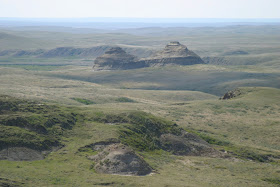Foraging is hot at the moment. I live in a semi-arid region and the pickings are slim. To compensate I have ordered a Community Supported Foraging box from northern Saskatchewan. It arrives monthly and is better than Christmas. I feel so spoiled.
This month the box contained an inordinate amount of burn morels. I splurged with this recipe for morel and bacon jam.
I am compelled to give a plug to my professional forager. I haven't met Elisabeth in person but I feel we are kindred souls. One day I will make the trek north and visit. You can find all her products on her website
Prairie Infusions. She ships these delicacies all over North America. Give her a call.
However, if you are interested in foraging take the time to learn how to do it properly.
-->
Learn the Latin name of plants rather than using common names.
Common names vary from region to region. Learn habitat and companion plants.
Where do you expect to find berries? What plants tend to grow in proximity to
each other?
Plants can be picked throughout the year. Learn what is available
in each season. Learn which parts of the plant are safe to eat and when to
harvest. For example, stinging nettle should not be eaten after it has gone to
seed.
Responsible foraging should be top of mind. Do not pick more than
10% even in a large patch. And definitely do not pick what you won’t use.
Harvest only the part of the plant you intend to use. A guide is to only
harvest 25% of the plant unless of course you are intending to use the root,
such as cattails or wild onions.
Be aware of endangered plants, such as ramps. Ramps are illegal to
pick in the wild due to diminishing numbers caused by over-harvesting.
Safety is another important concern. When harvesting water plants
be aware of the source of the water. Any toxins in the water will be in the
plant. Cattails in a slough may be contaminated with farm chemicals. Or plants
in ditches may be contaminated with road maintenance products and automobile
exhaust.
Morel and Bacon Marmalade
Wild picked morels will have some grit if not washed before use.
But be careful not to soak them. Wash quickly in two changes of water and use
immediately.
8 oz. fresh morel mushrooms 250 g
4 slices bacon or pancetta
5 tbsp. butter, divided 75 mL
fresh thyme
1/2 c. beef, veal or mushroom stock 125 mL
1 c. carrots, diced 250 mL
1 c. shallots, diced 250 mL
1/2 c. Marsala or red port wine 125 mL
1/4 c. red wine vinegar 60 mL
1 tbsp. brown sugar 15 mL
1 tsp. black pepper 5 mL
kosher or sea salt to taste
Cook bacon until lightly crisp. Remove and add morels, two
tablespoons (30 mL) butter and a pinch of salt to the pan. Cook mushrooms until
soft, have released all their water and are nicely browned. Add stock and two
sprigs of thyme. Simmer until almost all of the liquid has evaporated but the
mushrooms are still moist. Remove mushrooms from pan and set aside. Discard
thyme.
Add three tablespoons (45 mL) of butter. Saute shallots and
carrots with a pinch of salt until softened, about eight minutes. Add sugar,
vinegar, pepper and wine. Cook over medium heat until the liquid is reduced to
a very small amount. Scrape up all the bits on the bottom of the pan
Chop mushrooms and bacon and add to sauce. Reduce further if
necessary. You want it to be moist but not runny. Taste to adjust salt and
pepper. It should taste peppery.
Serve warm with toasted thinly sliced baguette. Garnish with
Labrador Tea.


















































